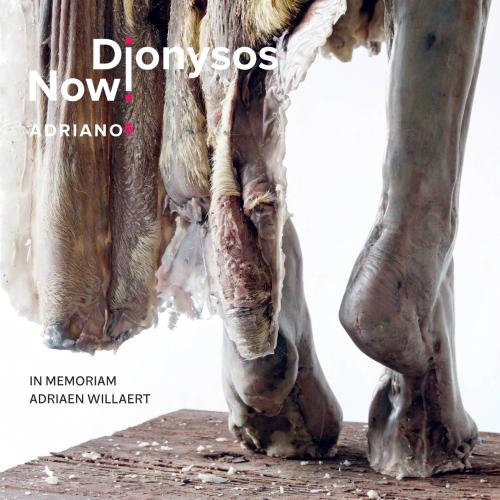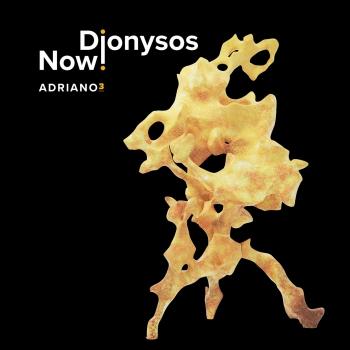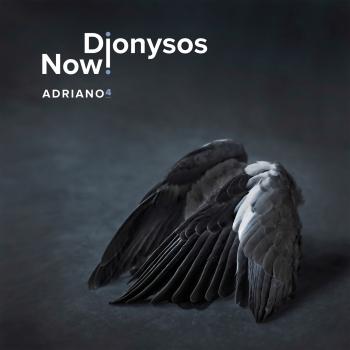
Adriano 5 Dionysos Now
Album info
Album-Release:
2024
HRA-Release:
03.05.2024
Label: Evil Penguin Classic
Genre: Classical
Subgenre: Vocal
Artist: Dionysos Now
Composer: Cipriano de Rore (1516-1565), Andrea Gabrieli (1510-1586), Adrian Willaert (1490-1562), Giovanni Battista Conforti (1550-1605), Gioseffo Zarlino (1517-1590), Floriano Canale (1575-1612)
Album including Album cover Booklet (PDF)
- Cipriano de Rore (1516 - 1565): Concordes adhibete animos (de Rore):
- 1 Rore: Concordes adhibete animos (de Rore) 03:07
- Andrea Gabrieli (1533 - 1585): Sassi, palae:
- 2 Gabrieli: Sassi, palae 04:12
- Lorenzo Benvenuti: Giunto Adrian:
- 3 Benvenuti: Giunto Adrian 05:41
- Daniele Grisonio: Vu ha ben casun:
- 4 Grisonio: Vu ha ben casun 04:03
- Adriaen Willaert (1490 - 1562): Dulce Padrun:
- 5 Willaert: Dulce Padrun 04:48
- Alvise Willaert (1490 - 1562): Pianza’l Grego Pueta:
- 6 Willaert: Pianza’l Grego Pueta 05:29
- Gianbattista Conforti (1550 - 1570): S’hoggi son senz’honor:
- 7 Conforti: S’hoggi son senz’honor 02:30
- Gioseffo Zarlino (1517 - 1590): Parce mihi Domine:
- 8 Zarlino: Parce mihi Domine 04:28
- Taedet Animam meam:
- 9 Zarlino: Taedet Animam meam 05:04
- Manus tuae:
- 10 Zarlino: Manus tuae 03:27
- Adriaen Willaert: Dove sei tu, mio caro:
- 11 Willaert: Dove sei tu, mio caro 04:28
- Floriano Canale (1575 - 1612): Concordes adhibete animos (Canale):
- 12 Canale: Concordes adhibete animos (Canale) 03:41
Info for Adriano 5
"It has long been my desire to compile a single album of all the many elegies and songs of praise in which Maestro Adriaen Willaert is musically immortalized. In recent years, various musicological articles have been published that shed light on the music that pays tribute to Adriaen Willaert, composed in the period following his death on December 7, 1562. However, recordings and especially performances of most of these works have been lacking until now. All the more reason to fill this ‘vacuum’—which, for some works, spans over 400 years—with Dionysos Now!" (Tore Tom Denys)
In my research, I rediscovered a six-part composition by the (until now unknown to me) composer Floriano Canale (c.1550-1616?), who sets to music the same text Willaert’s “poulin” Cipriano De Rore (1515/16-1565) used in the ode to his teacher and mentor: Concordes adhibite animos. An ideal opportunity to start and end the recording with these two works, especially since they do not sound like typical ‘deplorations’ on the composer (deplorer = to mourn) but rather as “ceremonial motets” such as those written for emperors and cardinals, full of praise and honor, in Latin, with the typical reference to Greek mythology.
The madrigal Sassi, Palae van Andrea Gabrieli (c.1533-1583) by Andrea Gabrieli (c.1533-1583) is an imaginative invocation that calls upon everything that grows and swims in the canals of Venice—from the smallest plants to the mermaids (whether they be unmarried or married!)—to join in mourning. This appeal is based on the writings of one of the Commedia dell’Arte’s leading figures, Antonio Molino, also known as Manoli Blessi. Similarly, Pianza’l Grego Pueta by Alvise Willaert (fl.1560, Adriaen’s nephew) is based on a personal lamentation of Blessi on the great loss of the “Màstora della Musica.”
A true discovery for me was the madrigal Giunto Adrian vby Lorenzo Benvenuti. The lyrics (by an unknown author) are less personal compared to the other elegies, but no less intense: daring harmonies accompany this beautiful example of mystical poetry, demonstrating that—even though we know almost nothing about this composer—he knows perfectly how to imitate the composition style of Willaert and the way he set text to music, indeed even developing it further.
Giovanni Battista Conforti’s (fl. 1550-1570) S’hoggi son senz’honor has similarly allegorical lyrics, but they contrast with the added music. The rhythm of the vocal lines feels like a kind of undisturbed rippling in the calm waters of the lagoon. Only in the last line does it become clear that this sonnet is about the death of Adriaen.
is Adriaen Willaert’s opus ultimum, set to a text by Antonio Molino. In this work, Willaert announces his departure from this (music) world. After the first part, in which his (deceased) dog boasts (in the first person) from heaven how it cured him of his many ailments (by making the summer heat disappear at night), Adriaen decides to join his dog on the “other side.” After the first part, in which his (deceased) dog boasts (in the first person) from heaven how it cured him of his many ailments (by making the summer heat disappear at night), Adriaen decides to join his dog on the “other side.”
This madrigal could be a “musical reply” to an earlier work by Daniele Grisonio, also on a text by Antonio Molino, Vù ha ben casun. The two madrigals were published one after the other in the same print in 1564.
In the lyrics of Grisonio’s composition, the same deceased pet comforts its owner (Willaert) from heaven by assuring him that he will greet him every year in August in the form of the brightest star in the night sky, referring to the “dog star” Sirius.
I added the triptych Parce mihi Domine/Taedet Animam meam/Manus tuae* three “readings for the dead” by Willaert’s student—and later maestro di cappella at the San Marco Basilica—Gioseffo Zarlino (1517-1590), to this recording after reading the article “Deep mourning in Cinquecento Venice” by musicologists Antonio Chemotti and Katelijne Schiltz, which suggests that Zarlino could have composed this music for Adriaen Willaert’s funeral mass.
The madrigal ‘dove sei tu’ is by Adriaen Willaert himself, written after the death of an unnamed young man. (Tore Tom Denys)
Franz Vitzthum, countertenor
Filip Dámec, countertenor
Bernd Oliver Fröhlich, tenor
Jan Petryka, tenor
Tore Tom Denys, tenor
Tim Scott Whiteley, bass bariton
Joachim Höchbauer, bass
Dionysos Now
Tore Tom Denys, musical director
Dionysos Now
I would like to show you that vocal polyphony of the Renaissance is very captivating music, and deserves to be heard by a wider audience.
Dionysos Now! wants to create cathedrals from sounds, in which you perceive the music as if you were flattering the cathedrals with a drone from far above. The brick stones are overall but they seem to merge into the whole, into the 'gestalt', where the radiant music generates much more effervescent energy than the sum of the tones, the contagious flow in the music is sought and captured, like a surfer who seems to have found the perfect wave and seizes his chance to float on it before it goes away again.
With the wise words of Winston Churchill in mind "Never waste a good crisis", I started studying the scores of my fellow townsman Adriaen Willaert during the lockdown and so I rediscovered the wonderful music of this Venetian chapel master over the past few months. A new initiative was born: Dionysos Now! Vienna is a brand new project that aims to spread the magnificent heritage of Adriaen Willaert. With Dionysos Now!, I would like to demonstrate that Renaissance vocal polyphony is very captivating music that deserves to be appreciated by a wider audience.
Tore Tom Denys, founder Dionysos Now! Vienna
Anyone who reads the name Dionysos Now! correctly will discover the reference to Denys: Tore Tom Denys is the founder and artistic director of the ensemble.
Dionysos Now! is also in Greek mythology the growth force of the earth and human civilisation, zeal and enthusiasm, god of wine (construction) and fruit growing, poetry, theatre and music. As god of peace he brings people together and as victor over death he is god of the underworld. In various ways he had an important influence on the life, thought and work of the Greeks and Romans.
An ideal figurehead, therefore, from a great recognition for Willaert's work, to want to share this oeuvre with a large audience in the most diverse forms with great enthusiasm. It is Tore Tom Denys' ambition to map out the work of his "fellow townsman" by means of concerts and original CD recordings and to give him the fame he deserves.
The ensemble works and rehearses from Vienna but has an international base and unites top soloists in polyphony. Tore Tom Denys has his own clear vision on how he wants to perform Willaert's oeuvre with care for the original manuscripts and scores.
Ensemble Dionysos Now! is a flexible project in which the basis consists of 6 voices which, depending on the programme, can be extended to polyphonic or supplemented with an instrumental ensemble. To this end, a permanent collaboration will be set up with various internationally renowned ensembles.
Tore Tom Denys
has worked and lived in Vienna for over 20 years but was born and raised in Roeselare.
Tenor Tore Tom Denys joined the vocal core of the Capilla Flamenca in 2006. He studied trumpet at the Conservatory of Antwerp and could be heard worldwide as a concert and solo trumpet player. From 1994 to 1998, as a member of the 'World Youth Choir', he visited all continents, where his interest in early music and the art of singing grew steadily and he changed the trumpet for singing. He was a member of the vocal ensemble Currende with whom he recorded several CD's and was co-founder of the Goeyvaerts Consort. etc...
In 1998 Tore Tom Denys moved to Vienna and studied singing at the "Konservatorium der Stadt Wien". He was admitted to the "Arnold Schönberg Chor" (conducted by Erwin Ortner) and went on various tours as a soloist with this choir. Since 1999 he has been a member of the choir of the Vienna State Opera and has performed with it at the "Salzburger Festspiele" in productions by L. Maazel, R. Muti, Gjergiev W. Sawallisch. Besides his performances at various festivals in Austria and abroad, he is a permanent soloist with the ensembles "Nova", "Armonico Tributo Austria", "Cinquecento" and "Clemencic Consort". He is also founder and singer of the ensemble "Vivante", an ensemble for early music, which mainly performs music from the Italian Early Baroque and Ensemble Dionysos Now!, with a focus on polyphony. He is also a much sought-after soloist by Philippe Herreweghe with Collegium Vocale Gent for the specific polyphony music.
Booklet for Adriano 5


















